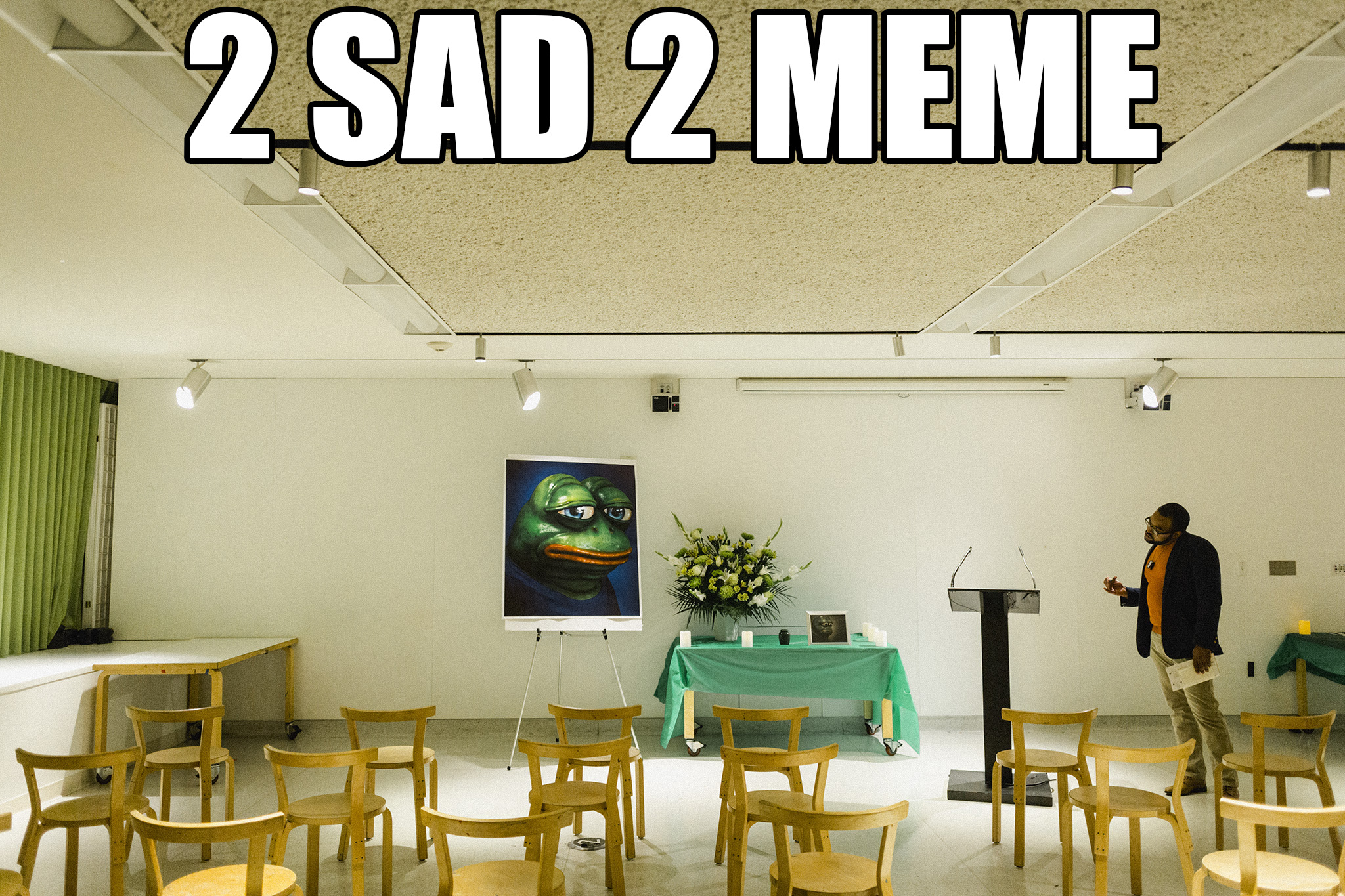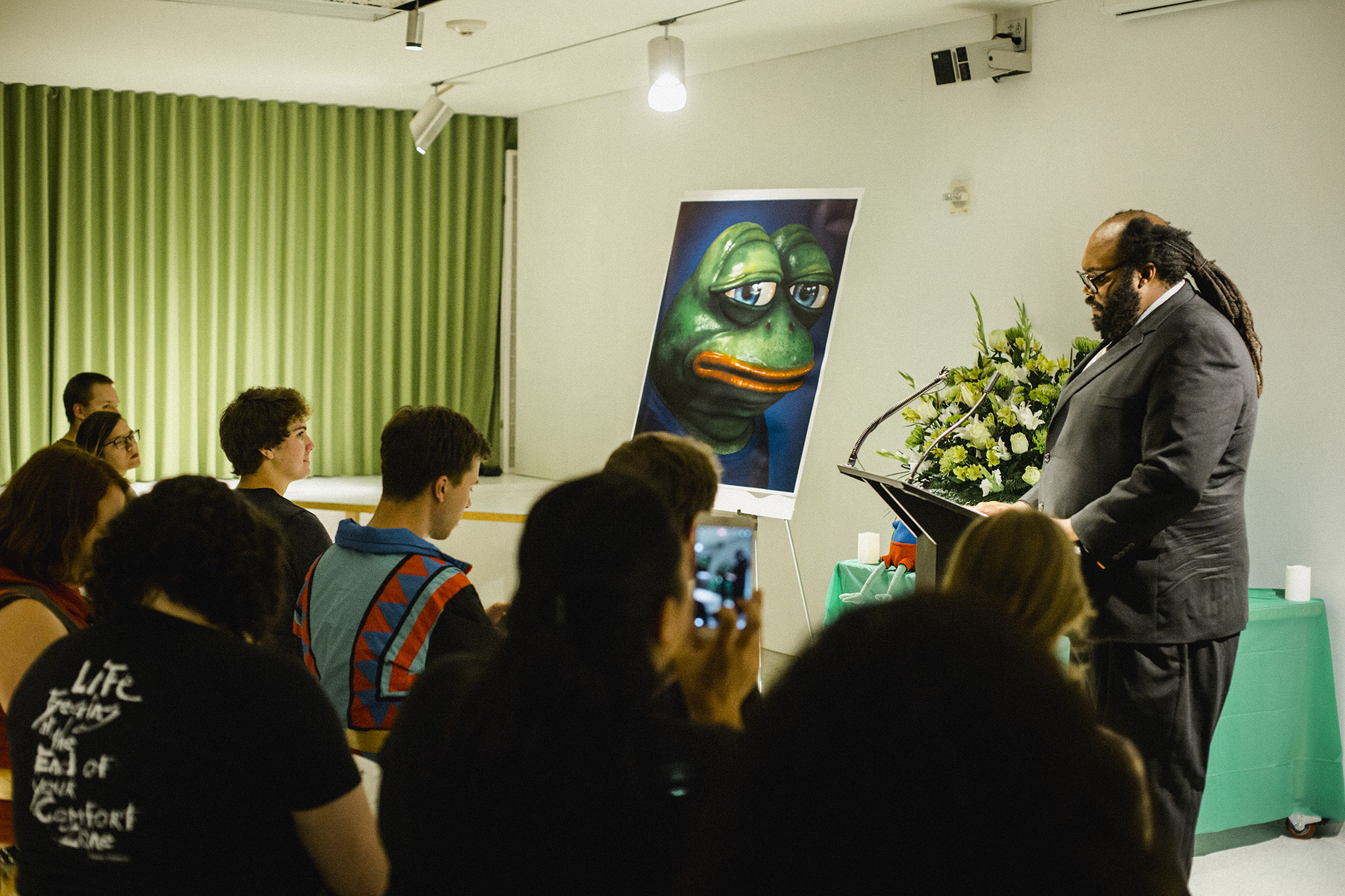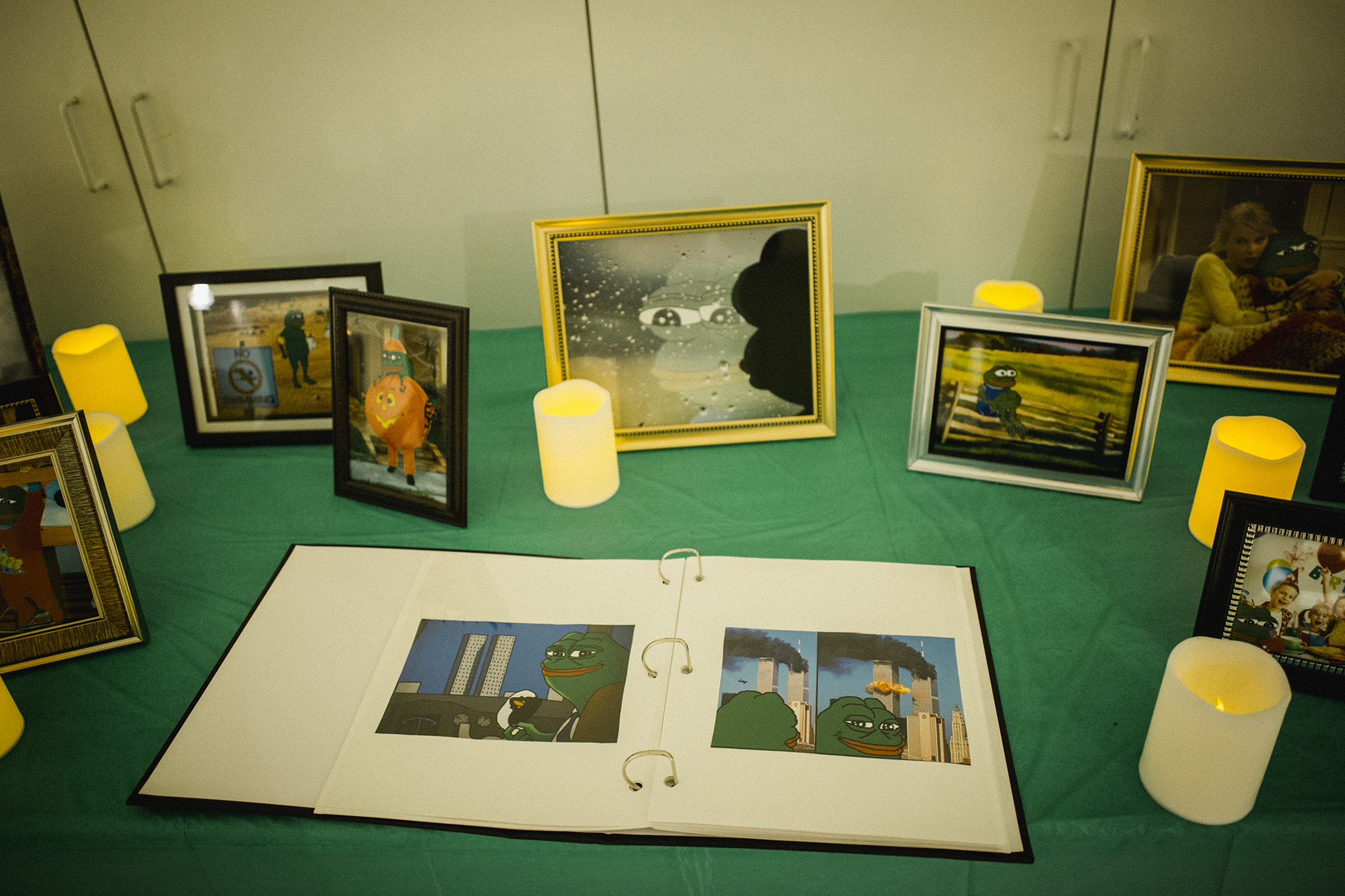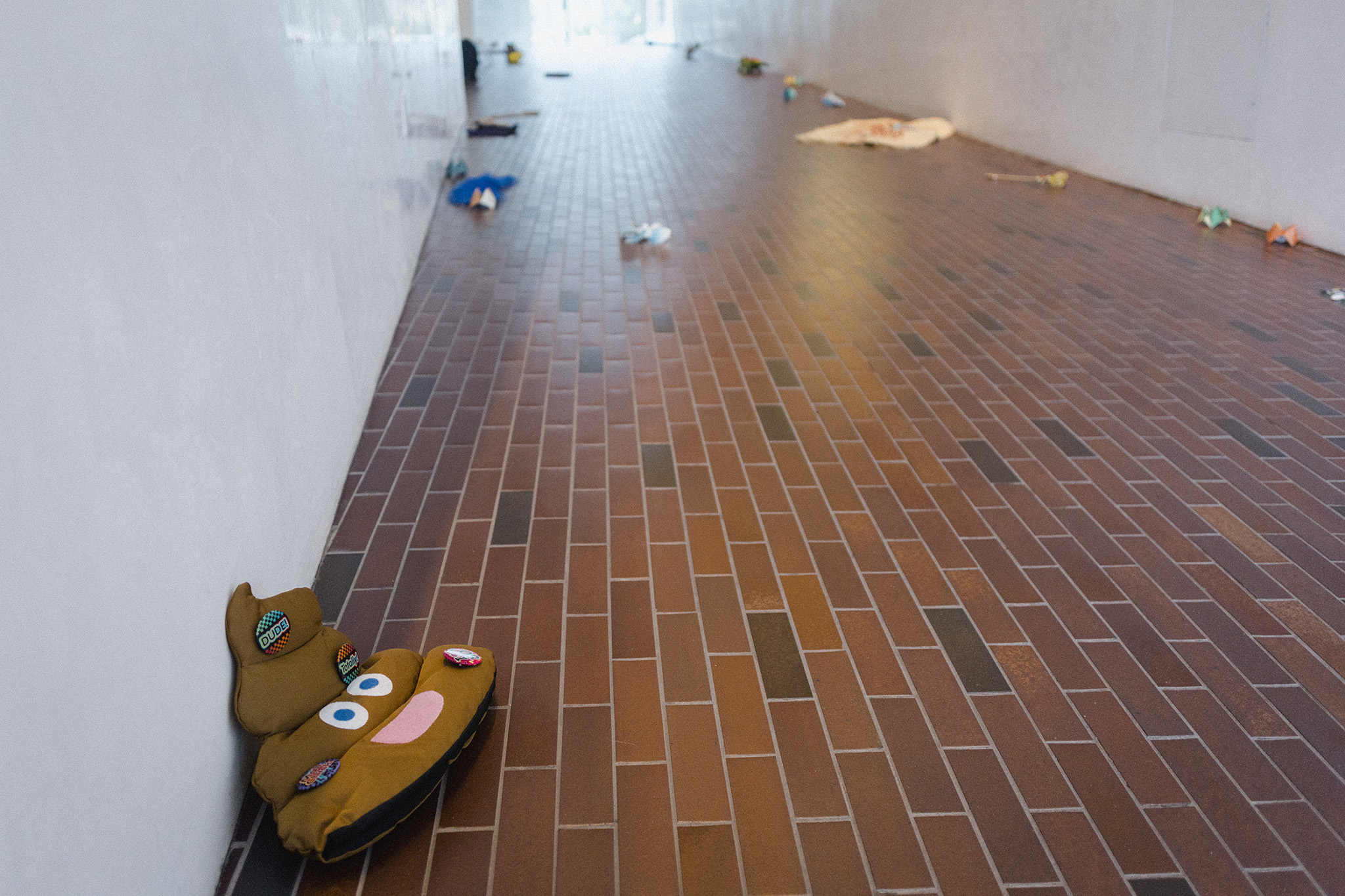A Memeorial: To Lay a Hate Symbol to Rest
Responding to Mn Artists Presents: Eric Larson’s Meme Town, Jordan K. Thomas considers the corruption of memes, anonymity and racism in digital space, and what it means to lay a hate symbol to rest.

A man stands at a podium, dressed in a fine black suit, to deliver a eulogy. This is Chris Cloud, a self-described Culture Maker™ who has delivered lectures on the arts at the University of Minnesota, to the Metropolitan Regional Arts Council, and in a TedX presentation, to name a few. Cloud has also created dance parties in the Twin Cities, launched digital publications on the arts, and even created an overnight summer-camp style event for adults who love pizza and he has been interviewed for the Star Tribune, Pollen, and Huffington Post.
His accomplishments are as vast and noteworthy as they are odd, and tonight he is adding one more to the list as he presides over a strange funeral, for behind Cloud is an image of the deceased: slime-slick green skin, long thin pink worm-like lips, red-tinged eyes. Cloud holds himself with great poise, somber and serious, as he speaks, his voice thick with emotion, of the dead, of Pepe the Frog.

It is early October and I am in the basement of one of Minneapolis’s most renowned museums, seated in a small room that looks as if it is, on any other occasion, a supply room or office space. But on this night, it is a funeral parlor lit by a wealth of fake candles, and the air is filled with the accordion-and-piano kind of French music that reminds me of the soundtrack to Amélie.
At the entrance to the room is a small table. On the table are two vases filled with fresh flowers, a box of tissues in the shape of Pepe’s head, and a guestbook that attendees are encouraged to use to leave some words, some thoughts on the dead. I am one of the first to enter the room and, even then, I find that someone has already scrawled “First!” in the guestbook, mimicking the comments sections and message boards where Pepe was most alive.
Along one wall is a table with several framed “photos” of Pepe. Pepe on a bench in a field. Pepe at a birthday party, Pepe looking at his reflection in a rain-covered window. On the table, too, is a book with more photos of the late Pepe: Pepe fading out with a needle in his arm, Pepe holding his cum-spurting cock, Pepe in a Nazi uniform, Pepe shouting, “White Power!”

And still, Cloud, who is himself a black man, is speaking of Pepe with fondness, the way one might speak of friend who has passed. Others in the audience laugh, participate in the farcical funeral, share in the moment, bemoaning the loss of this being. And it feels strange to me, bizarre, troubling. Because I cannot remove from my mind the images I’ve seen of Pepe in that photo album and on the internet, the images of Pepe clad in SS regalia, of Pepe in front of a number of nooses, of Pepe wearing a Ku Klux Klan hood and robe.
All of which leaves me sitting in that dim room wondering: Why?
***
Pepe came into existence in 2005, but he wasn’t known to most until he became associated with neo-Nazis, white supremacists, racists, white domestic terrorists, and Trump supporters over the course of the past two years and, in particular, during the run-up to the 2016 election. It was then that Pepe became a hot topic in the news. It was labeled a hate symbol, even, by the Anti-Defamation League.
I remember being amused at the discussions around Pepe that were taking place on the radio, in news articles, by the media, because the coverage reminded me of the way older folks sound when they attempt and fail to use current slang, like those corny dads in TV shows saying things are “off the chain”. But, mostly, I was dumbfounded—if not downright furious—by their giving Pepe a platform in the first place.
The narrative around Pepe is that he was coopted by the neo-Nazi, white supremacist, racist wings of the internet, especially on websites like 4chan. Prior to that, so the narrative goes, he was an innocent and carefree frog. And there’s truth to it, certainly. But it ignores the actual social reality of the internet and the history of memes themselves.
***
I grew up on the internet. I don’t mean that I grew up with the internet. No, I grew up on the internet. I was a deeply depressed, reclusive, angry, black boy who lived in an extremely abusive household in the very white suburbs of Iowa. The internet was my survival, my lifeblood. I was young when I learned things I shouldn’t have learned, saw things I shouldn’t have seen. I was eleven when I watched a man get decapitated by a helicopter blade. I was twelve when I watched a video of a cat being tortured to death. I was deep in a great many internet communities, a member of SomethingAwful, active on IRC and Usenet, and part of various message boards tucked away in corners of the internet. And I was present for—and part of—the advent and spread of some of the earliest memes. I was privy to the many permutations of All Your Base Are Belong to Us, the rise and fall of ytmnd.com, Admiral Ackbar’s “It’s a trap!”, and many other memes—before they were called memes—and viral content—before “going viral” was a thing—years before Pepe came onto the scene. And at no point in my history with the internet were these communities and these early memes detached from racist, sexist, misogynist, or homophobic beliefs or statements by community members and content creators.

In those early days, I omitted the fact of my blackness in my internet dealings. I made sure to betray no sense of my race on message boards or in chat rooms because, the moment I did I’d get private and public messages calling me a nigger. Anything I posted, anything I said, was immediately discounted and ignored. In any discussion even tangentially related to race, accusations of playing the race card or of blacks always whining about unfair treatment and slavery were the norm, not the exception. And when they were called out on it, they would claim that this was the internet, where nothing was serious, where everything was for the lols. And these were the same users who formed—who still form—the core of 4chan.
Which brings me back to the narrative surrounding Pepe. He found life on a website filled with people—mostly white men—who would claim up and down that they weren’t actually racist, sexist, or homophobic, while propagating memes and making posts that said otherwise. Even his name, Pepe, is suspect, with his portrayal as a lazy stoner not far off at all from stereotypical presentations of Latinx folks. Pepe wasn’t coopted but, rather, became an emblematic vessel for what was already present in the community that housed him.
Which, in turn, brings me back to my original question: Why?
Why a funeral for Pepe, of all things? Why a eulogy for this frog that took on the traits of its community and became a symbol for racism, for hatred and intolerance? Or, at the very least, why a funeral centering on Pepe rather than on the folks that Pepe has been used against? I remember sitting in that basement room and thinking, as people spoke so warmly of Pepe, of ICE raids and the travel ban and Charlottesville.
***
Pepe’s funeral was part of a larger event called Mn Artists Presents: Eric Larson’s Meme Town, curated by local artist and Meme Town Mayor Eric Larson. Larson’s own work has, in the past, looked at the political powers at play in microcosms such as the theater or, in this case, the meme-making and meme-consuming subculture of the internet. While the funeral was a focus of Meme Town, there were a few other interactive displays that also spoke to the ways in which memes are used, misused, corrupted.
In a project by Mitch Stahlmann on the first floor of the museum, for example, two computer screens seen through full fish tanks displayed a dizzying mess of text, image, animation. Clicking on the images would send you to another page equally full of esoteric, confusing, or bizarre information. That Stahlmann chose to display the screens behind water and, in doing so, warping the images seemed to mimic the internet’s own effect on information that, once disseminated and set adrift in the waters, becomes twisted, altered, or distorted.

I understand the idea, of course. I understand the desire to reclaim and exonerate Pepe, to free him from the clutches of white supremacy and from the perversion of his very being. And there is something potent in laying Pepe to rest, in declaring him dead, to be sure. In naming him a dead meme and a deceased figure of the internet, it takes some of Pepe’s power away, just as there is something potent in taking Pepe as seriously as white supremacists do and, with that faux seriousness, making light of or mockery of their rage, susceptibility, and ignorance. But I saw no one in that room who wasn’t already on board with the political message at play.
One of the ideas behind Meme Town was a focus on how images and memes can be corrupted, manipulated, twisted for nefarious purposes or how images and memes can corrupt, manipulate, and twist others to the same end. But, even setting aside my belief that Pepe was not, in fact, corrupted or coopted, I struggle with the idea of eulogizing Pepe because what he stands for has had real, tangible effects, resulting in lives ruined and lost, regardless of the original intent. And providing a platform and this wry, humorous proceeding, when the very people who propagated the various images and memes of Pepe continue to harm and terrorize—as Richard Spencer and his ilk did in returning to Charlottesville on October 7, two days after Meme Town—does a continued disservice to those engaged in opposing, at great personal cost, what Pepe stands for.
The act of reclamation does not turn back the effects of Pepe. It does not de-escalate the neo-Nazis and white supremacists who still wield Pepe as an icon, and it does not unmake the Trump presidency, fueled as it was by Pepe and his supporters, and it does not bring back the wrongfully deported, the wrongfully imprisoned, or the wrongfully dead, who will not be remembered or spoke of fondly and humorously in museum basements.
This piece is published in conjunction with Mn Artists Presents: Eric Larson’s Meme Town. The event took place on October 5, 2017 at the Walker Art Center, and included artistic and discursive contributions from Mitch Stahlmann, Paige Carlson, Ryan Aasen, Meena Mangalvedhekar, Chris Cloud, Rye Gentleman, Claire Carroll, Ziyang Wu, and Skyler Nowinski.
This article was commissioned and developed as part of a series by guest editor Jordan Rosenow.